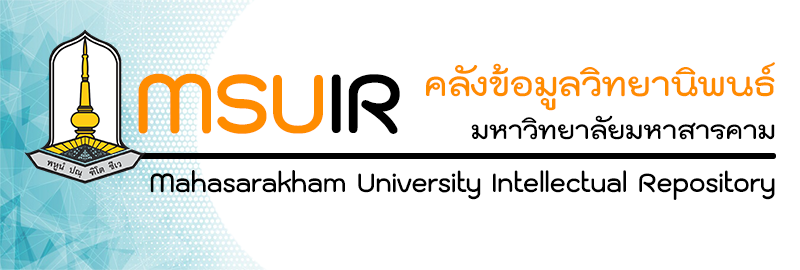Please use this identifier to cite or link to this item:
http://202.28.34.124/dspace/handle123456789/2854| Title: | Application of the concept of Outcome-Based Education in Evaluation of PhD Curriculum Program
in Curriculum and Instruction, Mahasarakham University การประยุกต์ใช้แนวคิดการจัดการศึกษาที่เน้นผลลัพธ์ ในการประเมินหลักสูตรปรัชญาดุษฎีบัณฑิต สาขาหลักสูตรและการสอน มหาวิทยาลัยมหาสารคาม |
| Authors: | Nilobon Sujinpram นิโลบล สุจินพรัหม Jiraporn Chano จิระพร ชะโน Mahasarakham University Jiraporn Chano จิระพร ชะโน jiraporn.j@msu.ac.th jiraporn.j@msu.ac.th |
| Keywords: | การประเมินหลักสูตร AUN-QA การศึกษาที่เน้นผลลัพธ์ Curriculum Evaluation AUN-QA Outcome-Based Education |
| Issue Date: | 20 |
| Publisher: | Mahasarakham University |
| Abstract: | The objective of this research is to 1) evaluate the Philosophy Doctoral Program in Curriculum and Instruction Management at Mahasarakham University, which emphasizes outcome-based education. 2) analyze the strengths and areas for development of the curriculum. Data collection utilizing interview methods with 2 curriculum coordinators, 3 instructors, 9 students, 8 graduates, and 1 graduate user, totaling 23 individuals. Data analysis involved content analysis, presenting evaluation results based on outcome-based education principles. The findings revealed significant strengths and areas for improvement as follows: Principle 1: Clearity of Focus Strengths: 1) Program Learning Outcomes (PLOs) align with the Thai Qualifications Framework (TQF) standards and are developed using Bloom’s Taxonomy. 2) The curriculum specifies PLOs that include both Generic Learning Outcomes (GLOs) and Specific Learning Outcomes (SLOs). Areas for improvement: 1) The curriculum should demonstrate the expected learning outcomes aligned with the vision and mission of the faculty and university. 2) The curriculum should specify PLOs for Study Plan 1.1 and Study Plan 2.1. Principle 2: Expand Opportunity Strengths: 1) Students engage in active learning in every course. 2) Instructors provide diverse feedback to students in a timely manner. Areas for improvement: The curriculum should consider specifying life-long learning skills needed for graduates and assign core courses for life-long learning skill development. Principle 3: High Expectations Strengths: The curriculum includes supplementary activities such as hands-on research training, research publication both domestically and internationally, promotion of research funding, and international publication dissemination. There are also student development projects for international academic conferences and study tours. Areas for improvement: 1) Consider establishing criteria and assessment methods for achieving/non-achieving Program Learning Outcomes (PLOs). Principle 4: Backward Design Strengths: 1) The curriculum conducts Curriculum mapping, illustrating the alignment with the Program Learning Outcomes (PLOs) of various courses. 2) The curriculum has a systematic course sequencing with curriculum analysis. Areas for improvement: Each course should consider creating Course Learning Outcomes (CLOs), notifying students of these CLOs, and specifying methods for measuring CLOs. การวิจัยในครั้งนี้ มีวัตถุประสงค์เพื่อ 1) ประเมินหลักสูตรปรัชญาดุษฎีบัณฑิต สาขาหลักสูตรและการสอน มหาวิทยาลัยมหาสารคาม ที่ประยุกต์ใช้การจัดการศึกษาที่เน้นผลลัพธ์ 2) วิเคราะห์จุดแข็ง และจุดที่สามารถพัฒนาได้ของหลักสูตร การเก็บรวบรวมข้อมูล ใช้วิธีการสัมภาษณ์ ประกอบด้วย อาจารย์ผู้รับผิดชอบหลักสูตร 2 คน อาจารย์ผู้สอน 3 คน นิสิต 9 คน บัณฑิต 8 คน และผู้ใช้บัณฑิต 1 คน รวม 23 คน การวิเคราะห์ข้อมูลใช้วิเคราะห์เนื้อหา และนำเสนอผลการประเมินตามหลักการจัดการศึกษาที่เน้นผลลัพธ์ พบว่า หลักสูตรมีจุดแข็งที่สำคัญ และจุดที่สามารถพัฒนาได้ตามลำดับ ดังต่อไปนี้ หลักการที่ 1 การมุ่งเน้นไปที่ผลลัพธ์ที่ชัดเจน จุดแข็ง คือ 1) ผลลัพธ์การเรียนรู้ที่คาดหวังของหลักสูตร (PLOs) สอดคล้องกับกรอบมาตรฐานคุณวุฒิระดับอุดมศึกษา (TQF) และมีการใช้ Bloom’s Taxonomy ในการสร้าง PLOs ของหลักสูตร 2) หลักสูตรมีการกำหนด PLOs ของหลักสูตรที่มีทั้ง GLOs และ SLOs จุดที่สามารถพัฒนาได้ คือ 1) หลักสูตรพิจารณาแสดงผลการเรียนรู้ที่คาดหวังของหลักสูตรที่สอดคล้องกับวิสัยทัศน์ พันธกิจ ของคณะและมหาวิทยาลัย 2) หลักสูตรพิจารณากำหนดให้มี PLO ของแผนการเรียน 1.1 และแผน 2.1 หลักการที่ 2 การขยายโอกาสและสนับสนุนความสำเร็จ จุดแข็ง คือ 1) ผู้เรียนได้เรียนรู้แบบ Active learning ทุกรายวิชา 2) อาจารย์ผู้สอนแต่ละรายวิชามีการให้ข้อมูลป้อนกลับกับผู้เรียนด้วยวิธีที่หลากหลาย ในเวลาที่เหมาะสม จุดที่สามารถพัฒนาได้ คือ หลักสูตรพิจารณากำหนดทักษะการเรียนรู้ตลอดชีวิตที่ต้องการของผู้สำเร็จการศึกษา และมอบหมายรายวิชาที่เป็นหลักในการพัฒนาทักษะการเรียนรู้ตลอดชีวิต หลักการที่ 3 ความคาดหวังสูง จุดแข็ง คือ หลักสูตรมีกิจกรรมเสริมหลักสูตร เช่น มีการอบรมเชิงปฏิบัตการด้านการวิจัย การตีพิมพ์เผยแพร่ผลงานวิจัย ทั้งในและต่างประเทศ การส่งเสริมสนับสนุนทุนวิจัย และทุนเผยแพร่ตีพิมพ์ระดับนานาชาติ มีโครงการพัฒนาศักยภาพนิสิต เพื่อการประชุมวิชาการระดับนานาชาติและการศึกษาดูงานต่างประเทศ จุดที่สามารถพัฒนาได้ คือ 1) พิจารณากำหนดเกณฑ์ และวิธีการประเมินการบรรลุ/ไม่บรรลุ PLOs หลักการที่ 4 การออกแบบการสอนย้อนกลับ จุดแข็ง คือ 1) หลักสูตรมีการทำ Curriculum mapping ที่แสดงให้เห็นถึงการผลักดัน PLOs ของรายวิชาต่างๆ 2) หลักสูตรมีการลำดับรายวิชาอย่างเป็นระบบ โดยมีการวิพากษ์หลักสูตร จุดที่สามารถพัฒนาได้ คือ แต่ละรายวิชาพิจารณาสร้าง CLOs และแจ้ง CLOs และวิธีการวัด CLOs ไปยังผู้เรียน |
| URI: | http://202.28.34.124/dspace/handle123456789/2854 |
| Appears in Collections: | The Faculty of Education |
Files in This Item:
| File | Description | Size | Format | |
|---|---|---|---|---|
| 65010558003.pdf | 19.9 MB | Adobe PDF | View/Open |
Items in DSpace are protected by copyright, with all rights reserved, unless otherwise indicated.

